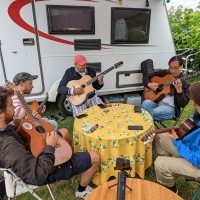DjangoBooks.com
Welcome to our Community!
Categories
- 20K All Categories
- 1.1K General
- 475 Welcome
- 59 Archtop Eddy's Corner
- 146 CD, DVD, and Concert Reviews
- 383 FAQ
- 26 Gypsy Jazz Italia
- 24 Photos
- 202 Gypsy Picking
- 21 Unaccompanied Django
- 15 Pearl Django Play-Along Vol.1
- 17 Gypsy Fire
- 45 Gypsy Rhythm
- 1.4K Gypsy Jazz University - Get Educated
- 130 Gypsy Jazz 101
- 223 Repertoire
- 218 History
- 707 Technique
- 51 Licks and Patterns
- 6 Daniel Givone Manouche Guitare Method Users Group
- 20 Eddie Lang Club
- 1.3K Gypsy Jazz Gear
- 799 Guitars, Strings, Picks, Amps, Pickups and Other Accessories
- 457 Classifieds
- 49 Recording
- 62 Other Instruments
- 18 Violin
- 5 Mandolin
- 22 Accordion
- 7 Bass
- 10 Woodwinds
- 345 Gypsy Jazz Events
- 141 North America
- 109 Europe
- 95 International











Comments
He can play this style of rhythm as good as anyone on the scene today so you went to the right guy.
But I'd guess he said that they aren't muted.
Even if they sometimes sound muted, and sometimes they probably are because as good as these guys are they can't be perfect 100% of the time, thinking of those beats as muted is I think a wrong approach.
Rather, think of them a a drum brush hit, with a hint of a chord. There is only enough pressure on the strings to give a slight hint of notes but loose enough to be percussive.
I do similarly as you though, meaning I listen a lot to what I wanna crack and try to imitate and try to be aware of the sound I'm making and do small adjustments as I play and listen for changes, better or worse. And lastly I figure if I do it long enough I'll get close.
Buco
Adrian didn't correct me if I called it "muted," but he refers to it as "music/percussion" with the 1 and 3 beats being music and the 2 and 4 beats being percussion. You can get the drift of this by looking at Archtop Eddy's Corner on the forum here, "AE Video: Finding the Elusive Gyspy Swing Rhythm!" I think we can probably agree that in this style the pitches in the chord on beats 2 and 4 are minimized to give a more percussive feel. However, Adrian stressed that it's important to play through all of the strings on all beats. He showed me how I was shortening my stroke on beats 1 and 3 and didn't realize it until then. He also pointed out that in order to be able to play exactly like these new school players, one might have to find chord voicings that are more complementary to all strings being played through. That might be a challenge.
I've attached my interpretation of Adrien Moignard's fingering and chord progression for "Minor Swing" as demonstrated in the video. I left string B and E open to interpretation. Some people might prefer to press on the fret where the G string is pressed, where others might prefer to mute the B and E. In either case, all strings should be played through.
I watched the "elusive" video multiple times. It's great, one of the best ever done to show what's going on. It also showed that there isn't a single gospel but that you can have a lot of personal preference in your own choices. Once you get in the pocket there's room to make it swing your own way.